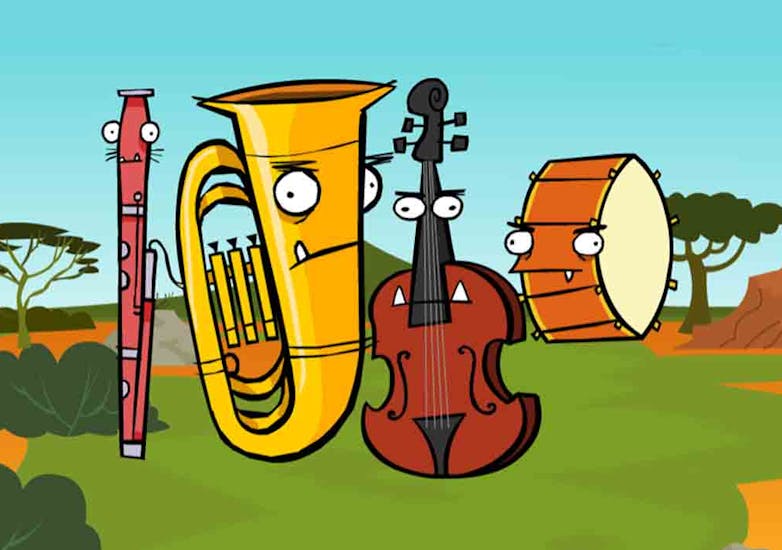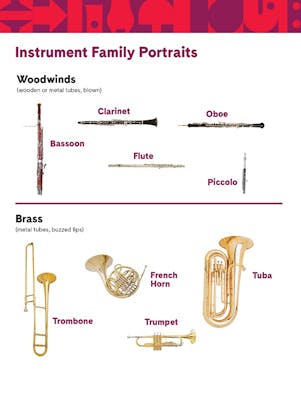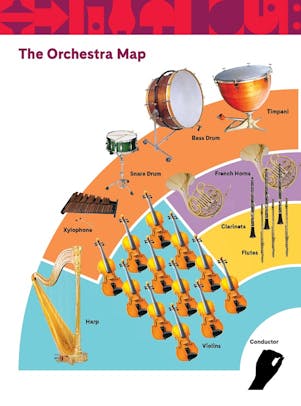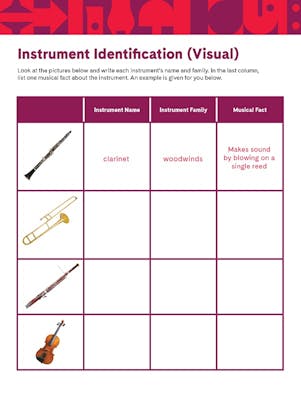Aim: What is an orchestra?
Summary: Students become familiar with the instruments and families of the orchestra.
Standards: National 6, 7, 8; NYC 1, 2, 3, 4, 5
Vocabulary: instrument, orchestra
Related Pages:

Share Your Feedback
As part of our continued efforts to improve your experience with Link Up, we would appreciate your feedback in this five-minute survey. As the Link Up community grows, we want to ensure that we are creating resources that are accessible and useful to as many teachers as possible. Your responses will help us better understand which Link Up resources are being utilized, and how.
Instrument Families Exploration
- Watch the video Families of the Orchestra below.
- Which instruments did you recognize?
- Did you see or hear any unfamiliar instruments?
- What are some other instruments that you are familiar with?
- At the Link Up concert, you will see and hear many types of musical instruments. Each instrument has unique characteristics, such as the different ways they produce a sound, the materials used to create them, and their overall appearance. These characteristics ultimately divide instruments into four families: woodwinds, brass, percussion, and strings.
- Play the four instrument family tracks below while students refer to Instrument Family Portraits (PDF). You can also use the Instrument Family Sounds (PDF) activity, which allows students to take notes as they listen.
- Pause after each instrument and ask the following questions:
- What do you notice about this instrument?
- What is unique about the way this instrument sounds?
- Below are some characteristics to keep in mind as you go through this activity with your students:
- Appearance (colors, shapes, sizes)
- Materials used (wooden tubes, metal tubes, reeds, double reeds, wooden bodies, strings)
- Mechanisms and structures (slides, valves, bells, f-holes, finger holes, mouthpieces, bridges, bows, keys, pads, separable sections, mutes)
- How sound is produced (breath, buzzing lips, fingers, bows, striking, shaking, scraping)
- Show students how the families are grouped together on the stage by reviewing The Orchestra Map (PDF).
Identifying Instruments and Families
Complete the following activities to assess your students’ knowledge of the instruments and their families. For additional instrument identification assessments, refer to the Music Skills Assessment (PDF).
Part 1 (Visual)
- Complete the activity Instrument Identification (Visual) (PDF).
- We are going to identify instruments of the orchestra. Fill in the boxes next to each image.
- Also, write in one musical fact about each instrument. Notice that the first example is completed for you.
- Have students form pairs and check one another’s work.
Part 2 (Audio)
- Play the eight instrument identification tracks below.
- Complete the activity Instrument Identification (Audio) (PDF).
- Compare and discuss answers.
- Play tracks again as needed.
Be the Conductor
- Discuss the role of the conductor in an orchestra.
- Why does an orchestra need a conductor?
- How does a conductor communicate with the orchestra during a performance without talking?
- Conductors direct the orchestra using arm movements called “beat patterns” that indicate the meter and tempo of a piece of music. Demonstrate the 4/4 beat pattern pictured below.
- When a piece has a 4/4 time signature, the conductor uses this pattern with his or her right hand (down, left, right, up).
- Use your pointer finger as your conductor’s baton and practice your 4/4 beat pattern.
- Next, have the students in the class establish a slow, steady beat by patting their knees and counting “1, 2, 3, 4.”
- While half of the class maintains the steady beat, invite the remaining students to practice the 4/4 beat pattern in time.
- Have individual students lead the class as the conductor while the students count, being careful to follow the conductor’s tempo, dynamics, and expression.
- What other types of musical ideas might a conductor want to share with the orchestra besides the tempo and meter?
- As you practice your Link Up repertoire throughout the year, invite individual students to be the guest conductor and lead the class, making their own musical choices.
The Conductor
For all of the instruments of the orchestra to play together, they need someone to lead them. It is the job of the conductor to keep a steady beat for the musicians to follow, indicate dynamics and changes in tempo, and interpret a musical composition expressively. Conductors are highly trained musicians, many of whom have played one or more instruments for many years. Who will the conductor be at your Link Up concert?

Instruments Form Ensembles
- At the culminating Link Up: The Orchestra Swings concert, you will see two ensembles performing together: a symphony orchestra and a jazz ensemble consisting of piano, bass, drums, trombone, trumpet, and saxophone or clarinet.
- Refer to The Jazz Ensemble (PDF) to look at photos of different kinds of jazz ensembles.
- Which instruments do these ensembles have in common?
- What are some differences that you notice between the ensembles?
- Jazz ensembles come in many different sizes. Ensembles with less than 10 members are referred to by the number of musicians in the group:
Duo = two musicians
Trio = three musicians
Quartet = four musicians
Quintet = five musicians
Sextet = six musicians
Septet = seven musicians
Octet = eight musicians
Nonet = nine musicians - Jazz ensembles with more than 10 members, who are divided into sections, are often called big bands.
- You may notice that a jazz ensemble can include many of the same instruments as the orchestra, such as the trumpet, trombone, clarinet, flute, and bass. But some instruments used prominently in jazz—like the saxophone and guitar—are rarely found in orchestras. Sometimes jazz ensembles also feature a singer. Another defining characteristic of jazz ensembles is the importance of the rhythm section, generally made up of the piano, bass, drums, and sometimes guitar. While the rhythm section carries the beat, the other musicians in the band play the melody and have exciting musical conversations that they improvise on the spot.
The saxophone was invented by Belgian instrument maker Adolphe Sax in 1846
His goal was to create a woodwind instrument that combined the power of the brass instruments with the agility of the strings and would become a key part of the orchestra. While the saxophone has been used by many orchestral composers in their compositions, it was jazz musicians like Sidney Bechet, John Coltrane, and Charlie “Bird” Parker who popularized the instrument.
My Own Orchestra
- With the Instrument Family Portraits (PDF), study the instruments in their appropriate family boxes while listening to the four instrument family tracks below.
- Symphony orchestras are designed to play many kinds of music from various times and places. Orchestras from different cities all over the world include more or less the same instruments, sitting in more or less the same places.
- What if you designed your own orchestra to play a single special kind of music?
- Model and complete the activity My Own Orchestra (PDF).
- Share your work with Carnegie Hall by emailing linkup@carnegiehall.org.
My Own Jazz Ensemble
- Students can choose up to six more instruments to add to the rhythm section to create an ensemble.
- Which instruments do you think would sound good together? List or draw them in the activity My Own Jazz Ensemble (PDF).
- Legendary trumpet player Miles Davis created a nonet that included some instruments typically found in the orchestra, like the French horn and the tuba. The ensemble recorded a 12-track album called Birth of the Cool that was released in 1957.










